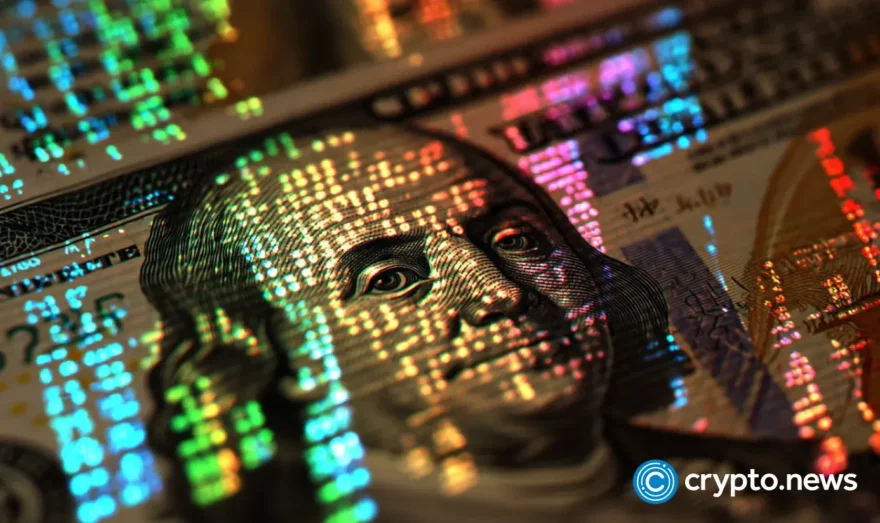Streamr: The Web3 Decentralized Real‑time Data Network

Streamr is a Web 3 open-source project and decentralized platform that relies on cryptography instead of trust. The platform provides tools essential to building a new data economy, as it is a peer-to-peer, real-time data infrastructure.
How Streamr Works
The way Streamr works is fairly simple. The pub/sub-network is composed of publishers and subscribers. It is a decentralized network that supports nodes all around the world. These nodes exchange data in exchange for validation and bandwidth.
Data brokers are nodes within the network; they process transactions, store information, and publish events to the stream. Like other blockchain networks, they utilize nodes to process transactions. That allows them to distribute the processing power and work efficiently.
Streamr provides a seamless and transparent way to exchange and monetize the data it collects. It utilizes smart contracts to ensure that the exchange process is carried out in real-time. The key element of this network is the broker nodes that provide validation and bandwidth.
To create a more complex structure that supports the exchange process, Streamr has developed several technologies. These include the Streamr Stack, a hierarchical framework designed to ensure that the process continues seamlessly. The five components of the Streamr Stack are smart contracts, the Streamr Engine, the data market, the Streamr Network, and the Streamr Editor.
What Problems Does Streamr (DATA) Solve?
Streamr focuses on providing solutions that help solve the problems related to the delivery of real-time data, including;
Provides a Tokenized Value to Real-Time Data
Through Streamr, real-time data can be tokenized and made available on the platform’s data unions and marketplaces. That is ideal for applications that are built on the Internet of Things (IoT), as well as decentralized applications. It’s also expected to be a vital component of Web3.
Focus on Network Optimization Technologies
According to Streamr, its competitive advantage lies in its off-chain nature, distinguishing it from other services in the same field. That eliminates the risks of scalability and bandwidth issues and ensures that the project can operate smoothly. It intends to use Ethereum’s network as its base. However, it is not planning on creating a special blockchain for the time being. Instead, it is focused on developing network tokenization technologies.
Offering Tools for the New Data Economy
Streamr is built on a real-time data infrastructure with various tools and resources designed for a new data economy. Its technology stack comprises various components, such as a real-time messaging network hosted on computers worldwide. It also has a marketplace that allows people to trade and sell their data.
Compensates for Lacking Capabilities by Switching Blockchains
Despite the criticisms about Ethereum, Streamr has found that it can meet its users’ needs at the moment. Although it might need more capabilities in the future, it is already well-equipped to handle its current needs. Developers can easily transfer their projects to another blockchain without going through the laborious process of establishing a link between them.
The Streamr Tech Stack
The Streamr Stack is a collection of layers that make up the network. The first layer is the Streamr Editor. That allows Streamr to use a P2P, real-time data infrastructure that houses not only its platform but many tools for a new data economy. The technology stack contains things like a scalable, real-time messaging network that is hosted on computers around the world.
There is also a special marketplace where data can be sold or traded and a set of tools designed for working with real-time information developers to create dApps and smart contracts. It also lets users monitor how these are executed and helps apply search filters for data.
The next layer is the Streamr Engine, which is responsible for analyzing and refining data. It will then send it to the developers and allow them to use it in their smart contracts and dApp. They can use various algorithms to make data deliverable in the form the user wants.
The Data Market is the feature that most users interact with on the platform. It allows people to buy and sell data. It also supports data from various devices, such as smart home appliances.
The Streamr Network is a collection of layers that allow users to move their data around. It consists of various protocols, smart contracts, and brokers that facilitate data transfer.
Lastly, smart contracts meet conditions before users can complete a transaction or deal. They keep the system secure and prevent unauthorized users from accessing the data.
Streamr Network
The Streamr Network is a distributed data transport layer that enables P2P networks to store and publish events. It features a publish/subscribe mechanism and can handle millions of events per second. The network’s throughput is linear and can be used to process large numbers of events per second. Here are some of the network’s features:
- Data transport & generalized messaging: Customers can use the network to publish and analyze data in real-time. They can use it to send and receive messages between various IoT objects and humans.
- Data sharing: The Streamr Network can deliver on the promise of open data by making information available to everyone. It enables data producers to share their data without requiring infrastructure investment. Most data producers, such as governments, can easily share their data without additional infrastructure.
- Data monetization: The Network can host Data DAOs(Data Unions), allowing people worldwide to contribute their data to a shared streaming asset. These data streams can be monetized using smart contracts.
Streamr Marketplace
The Streamr Network’s Marketplace allows users to buy and sell real-time data. It features a variety of free and paid products that enable data producers to monetize their content. The products come with subscription periods set by the network, and the currency used for transactions is the DATA token.
The marketplace is built on the Ethereum blockchain and the Streamr Network. Through the platform, data producers can securely store and manage their products. It also allows users to transact with other users using the DATA token.
The smart contract part of the marketplace provides data for buyers to interact with sellers directly. That eliminates the fees and commissions that traditional intermediaries typically charge. All the data collected and stored on the platform is delivered to the users through the Streamr Network.
Data Unions
The Data Union framework is a crowd sale and crowdsourcing platform that powers applications that allow people to earn from their data. It’s partnered with Ethereum and the Streamr Network.
A Data Union is a type of real-time data product that’s listed on the Streamr Marketplace. When a buyer subscribes to a Data Union, the revenue from the sale is automatically distributed to all of its producers. This product can be exported or bridged to other marketplaces at any time.
The most valuable Data Unions will allow people to collect datasets that are typically hard to find. Examples include real-time health data, pollution monitoring, and smart city data. Swash is the first Data Union that lets browser extensions monetize your browsing history.
DATA Token
The concept of DATA came about to compensate both the producers and consumers of data. It also incentivizes those who run data broker nodes in the P2P network giving a way for people to gain exposure to the value of data.
As an ERC20 token, DATA is used on Ethereum. It ensures that payments are handled securely and in a trustless manner. The smart contract of the token ensures that balances are maintained. Interoperability with other cryptocurrencies and wallets is ensured by following the standard of the ERC20.
Streamr is a platform that enables users to access real-time data. It’s designed for various applications, such as dApps and IoT devices. They believe that it is a vital component of Web 3.0.
The token supply was fixed at the end of the crowdfunding campaign in 2017. The total supply of $DATA is around 1,000,000,000. The Streamr token is distributed to the following groups: 65% to crowdfunding participants, 15% to the founding team, 15% to the treasury—3% to partners and consultants, and 2% to the community.
What Makes Streamr DATA Unique?
The broker nodes of the Steamr DATA network are the essential components of its operation. They process the data sent and received by the network’s providers.
To maintain the stream’s integrity, the network’s sponsors deposit their DATA tokens into a smart contract. These contracts are then used to protect the data stream. The broker nodes then use the Bounties to send the data to their subscribers.
The DATA token is a practical usage token used in the Streamr P2P network. It is used to compensate for the network’s data transport infrastructure. It can also be used as a transaction token on the platform’s marketplace.
How and Where to Buy Streamr DATA
The Streamr token is currently traded on over 40 different platforms. Some prominent exchanges supporting DATA include Binance, Uniswap, Bitfinex, WazirX, LATOKEN, Gate.io, CoinDCX, Pionex, Hotbit, Mercatox, HitBTC, Coinone, and Bitsonic.
Unlike other major cryptocurrencies, DATA is not directly purchased with fiat money. Instead, you can buy it through Bitcoin or other digital currencies. That means that you can easily buy it through a variety of exchanges.
Storing DATA
The good thing about DATA is that you can store it in various wallets supporting the ERC-20 protocol. That means you can easily store it in MyEtherWallet, one of the most popular online wallets.
You can also store DATA in a hardware wallet such as a Trezor or a Ledger Nano S. These high-end devices provide additional security features, such as pin codes and passphrases. While these are expensive, some people consider them to be worth the price due to their peace of mind knowing their high security.
Benefits of Streamr
We have looked at all features that Streamr has to offer. But what benefits does the platform bring along?
Provide and validate bandwidth and earn DATA
Nodes from all around the world power the decentralized pub/sub-network. These nodes can provide the project bandwidth and validation in exchange for their native DATA tokens. That benefits the project by allowing them to earn passive income while increasing their supply of tokens.
Earn as a Publisher
You can also join the group known as the Publishers. They are the project’s data providers and are rewarded for providing information. In addition, there is a group called the Sponsors. This group includes third parties and individuals interested in participating in the stream’s operation. They are required to pay DATA tokens to maintain the stream’s operation.
Access Data as a Subscriber/Consumer
Some users receive data from the network. These are called subscribers or consumers, as the data they receive is tied to the publishers’ publish/subscribe pattern. After the network’s sponsors pay for the privilege to secure the data stream, it is sent to these users through broker nodes focused on mining the funds from the smart contract.
The Future of Streamr
Unlike other blockchain projects, Streamr doesn’t have deadlines. Instead, they have miles that are designed to meet their goals.
The first step in building a successful ecosystem is to complete the prototypes for their various products, such as the Streamr Engine and the Marketplace.
In their second milestone, Streamr aims to complete the use of smart contracts for monetization and decentralize the various components of their platform, not only the marketplace but also the editor and engine.
Final Thoughts
The importance of data will never go away. As the internet continues to evolve into Web 3.0, projects such as Streamr will be vital to ensure that publishers have a seamless and rewarding experience regarding sharing information. As users’ privacy continues to become a key component of Web3, projects like Streamr will be able to help ensure that users can share their information only with the entities they want.
The customers can use data for various profitable and beneficial purposes by developing a platform where smart contracts guarantee that data transmission and licensing are handled carefully and appropriately. Streamr may be ushering in a new paradigm that might prevent more abuses of data possession and less leakage.















